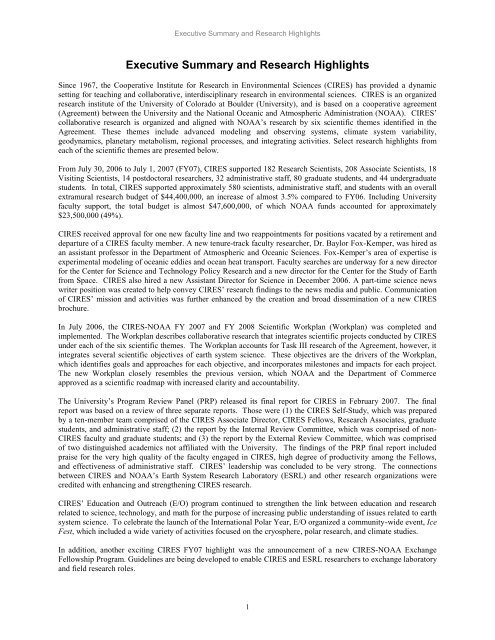Scientific Theme: Advanced Modeling and Observing Systems
Scientific Theme: Advanced Modeling and Observing Systems
Scientific Theme: Advanced Modeling and Observing Systems
Create successful ePaper yourself
Turn your PDF publications into a flip-book with our unique Google optimized e-Paper software.
Executive Summary <strong>and</strong> Research Highlights<br />
Executive Summary <strong>and</strong> Research Highlights<br />
Since 1967, the Cooperative Institute for Research in Environmental Sciences (CIRES) has provided a dynamic<br />
setting for teaching <strong>and</strong> collaborative, interdisciplinary research in environmental sciences. CIRES is an organized<br />
research institute of the University of Colorado at Boulder (University), <strong>and</strong> is based on a cooperative agreement<br />
(Agreement) between the University <strong>and</strong> the National Oceanic <strong>and</strong> Atmospheric Administration (NOAA). CIRES‘<br />
collaborative research is organized <strong>and</strong> aligned with NOAA‘s research by six scientific themes identified in the<br />
Agreement. These themes include advanced modeling <strong>and</strong> observing systems, climate system variability,<br />
geodynamics, planetary metabolism, regional processes, <strong>and</strong> integrating activities. Select research highlights from<br />
each of the scientific themes are presented below.<br />
From July 30, 2006 to July 1, 2007 (FY07), CIRES supported 182 Research Scientists, 208 Associate Scientists, 18<br />
Visiting Scientists, 14 postdoctoral researchers, 32 administrative staff, 80 graduate students, <strong>and</strong> 44 undergraduate<br />
students. In total, CIRES supported approximately 580 scientists, administrative staff, <strong>and</strong> students with an overall<br />
extramural research budget of $44,400,000, an increase of almost 3.5% compared to FY06. Including University<br />
faculty support, the total budget is almost $47,600,000, of which NOAA funds accounted for approximately<br />
$23,500,000 (49%).<br />
CIRES received approval for one new faculty line <strong>and</strong> two reappointments for positions vacated by a retirement <strong>and</strong><br />
departure of a CIRES faculty member. A new tenure-track faculty researcher, Dr. Baylor Fox-Kemper, was hired as<br />
an assistant professor in the Department of Atmospheric <strong>and</strong> Oceanic Sciences. Fox-Kemper‘s area of expertise is<br />
experimental modeling of oceanic eddies <strong>and</strong> ocean heat transport. Faculty searches are underway for a new director<br />
for the Center for Science <strong>and</strong> Technology Policy Research <strong>and</strong> a new director for the Center for the Study of Earth<br />
from Space. CIRES also hired a new Assistant Director for Science in December 2006. A part-time science news<br />
writer position was created to help convey CIRES‘ research findings to the news media <strong>and</strong> public. Communication<br />
of CIRES‘ mission <strong>and</strong> activities was further enhanced by the creation <strong>and</strong> broad dissemination of a new CIRES<br />
brochure.<br />
In July 2006, the CIRES-NOAA FY 2007 <strong>and</strong> FY 2008 <strong>Scientific</strong> Workplan (Workplan) was completed <strong>and</strong><br />
implemented. The Workplan describes collaborative research that integrates scientific projects conducted by CIRES<br />
under each of the six scientific themes. The Workplan accounts for Task III research of the Agreement, however, it<br />
integrates several scientific objectives of earth system science. These objectives are the drivers of the Workplan,<br />
which identifies goals <strong>and</strong> approaches for each objective, <strong>and</strong> incorporates milestones <strong>and</strong> impacts for each project.<br />
The new Workplan closely resembles the previous version, which NOAA <strong>and</strong> the Department of Commerce<br />
approved as a scientific roadmap with increased clarity <strong>and</strong> accountability.<br />
The University‘s Program Review Panel (PRP) released its final report for CIRES in February 2007. The final<br />
report was based on a review of three separate reports. Those were (1) the CIRES Self-Study, which was prepared<br />
by a ten-member team comprised of the CIRES Associate Director, CIRES Fellows, Research Associates, graduate<br />
students, <strong>and</strong> administrative staff; (2) the report by the Internal Review Committee, which was comprised of non-<br />
CIRES faculty <strong>and</strong> graduate students; <strong>and</strong> (3) the report by the External Review Committee, which was comprised<br />
of two distinguished academics not affiliated with the University. The findings of the PRP final report included<br />
praise for the very high quality of the faculty engaged in CIRES, high degree of productivity among the Fellows,<br />
<strong>and</strong> effectiveness of administrative staff. CIRES‘ leadership was concluded to be very strong. The connections<br />
between CIRES <strong>and</strong> NOAA‘s Earth System Research Laboratory (ESRL) <strong>and</strong> other research organizations were<br />
credited with enhancing <strong>and</strong> strengthening CIRES research.<br />
CIRES‘ Education <strong>and</strong> Outreach (E/O) program continued to strengthen the link between education <strong>and</strong> research<br />
related to science, technology, <strong>and</strong> math for the purpose of increasing public underst<strong>and</strong>ing of issues related to earth<br />
system science. To celebrate the launch of the International Polar Year, E/O organized a community-wide event, Ice<br />
Fest, which included a wide variety of activities focused on the cryosphere, polar research, <strong>and</strong> climate studies.<br />
In addition, another exciting CIRES FY07 highlight was the announcement of a new CIRES-NOAA Exchange<br />
Fellowship Program. Guidelines are being developed to enable CIRES <strong>and</strong> ESRL researchers to exchange laboratory<br />
<strong>and</strong> field research roles.<br />
1
















